The UEFA Europa League this season includes several big names, with Portuguese giants Benfica just one of them. This game saw them face a Rangers side in good form in Glasgow, in what looked on paper to be a really interesting game between the top two teams in the group. This tactical analysis will look at the tactics both sides used in the game, with Rangers controlling the first half, and Benfica coming back in the second half to earn a 2-2 draw and another point in the Group D table.
Lineups
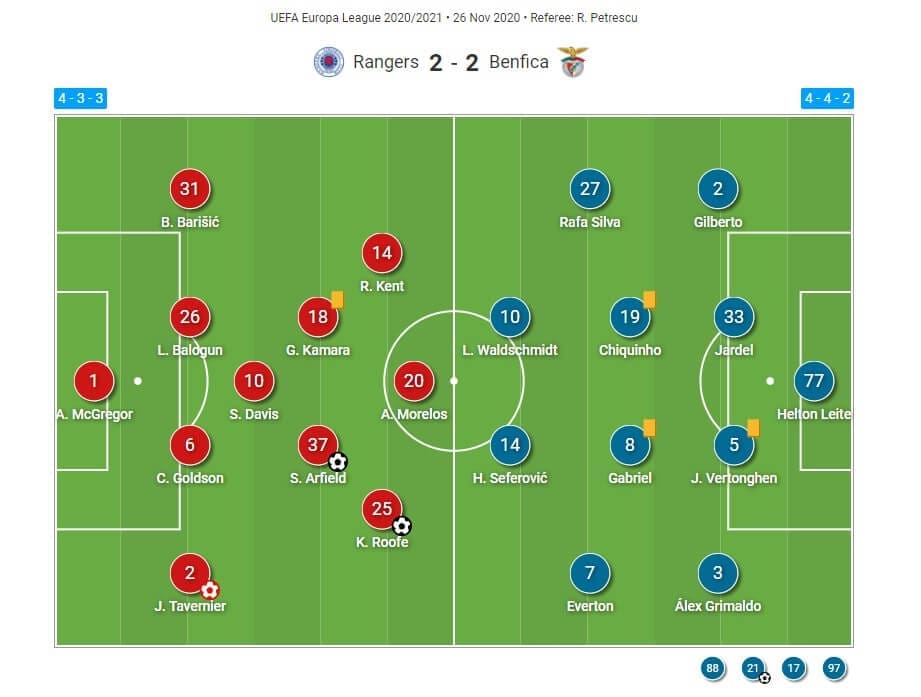
Rangers made just two changes from the side that beat Aberdeen 4-0 at the weekend, with Ryan Jack and Joe Aribo left out, and Finland midfielder Glen Kamara and Northern Ireland captain Steven Davis coming in to replace them. The back four was left unchanged, with former Brighton and Hove Albion defenders Leon Balogun and Connor Goldson again partnered together in the middle. Colombia striker Alfredo Morelos was flanked by former Liverpool winger Ryan Kent and former Leeds United striker Kemar Roofe at the other end.
Benfica, meanwhile, started with several key players in their team. Former Tottenham Hotspur defender Jan Vertonghen partnered Jardel at centre-back, whilst Switzerland striker Haris Seferović was partnered upfront by Everton Soares and Luca Waldschmidt. Their bench included winger Diogo Goncalves, who previously spent the 2018-2019 season on loan at Nottingham Forest, as well as Greece goalkeeper Odysseas Vlachodimos.
Rangers’ defence
Rangers started the game well, taking control early on. We will first look in this analysis at their defensive tactics.
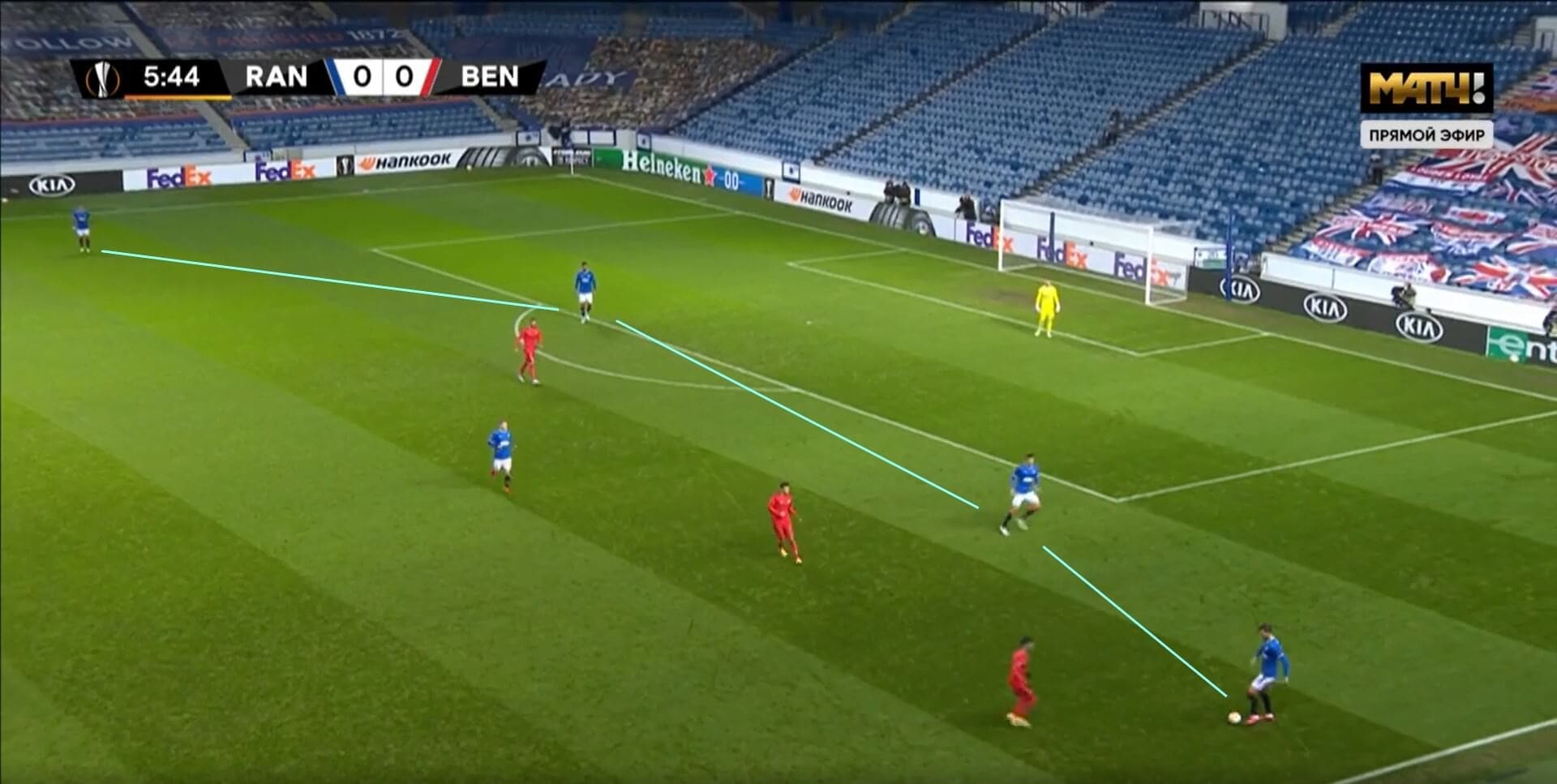
When Rangers were in possession, the defence was stretched out across the pitch, making it as big as possible. This ensured that it was difficult for Benfica’s attackers to close the ball down, because, if the ball was passed onto either side, and Benfica looked to move towards it, then the ball would just be moved down the line into the space. Similarly, if the ball was with either of the two central defenders, and they were closed down, then the two full-backs were available as passing options in space. There were gaps in between all four players, but this didn’t matter when they were in possession, because there was little danger of them losing the ball whilst they had this setup.
The image above demonstrates all of these points because the ball is on the nearside with three attackers looking to close down the three players nearest it. However, James Tavernier, the Rangers right-back, is open as a passing option, and so offers a way of moving the ball out of danger and then getting it forward.
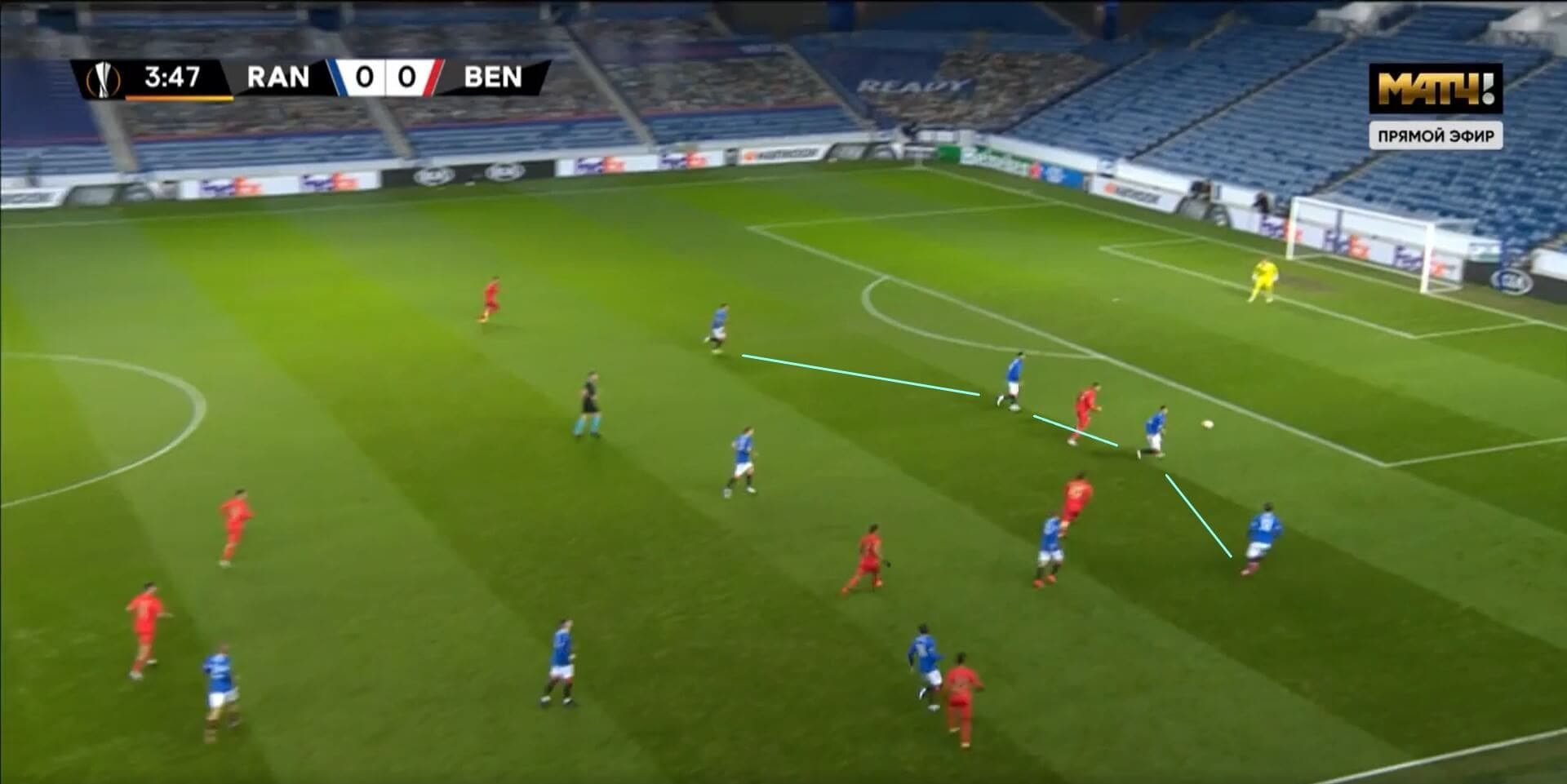
However, when Rangers lost the ball, they instantly brought their defence closer together, looking to close off the gaps, which were now routes for opposing attackers to get through them and into the space behind. In this image, we can see how Benfica are attacking, but there is no way for them to get through. Instead, when they pass the ball forwards, Rangers are able to meet the ball and clear it, ending the threat.
This constantly changing defensive shape meant that Rangers could use the space when in possession, but then stop their opponents getting behind them when they lost it, and this was one key reason why Benfica struggled to break their Scottish hosts down in the first half, aside from a few chances here and there.
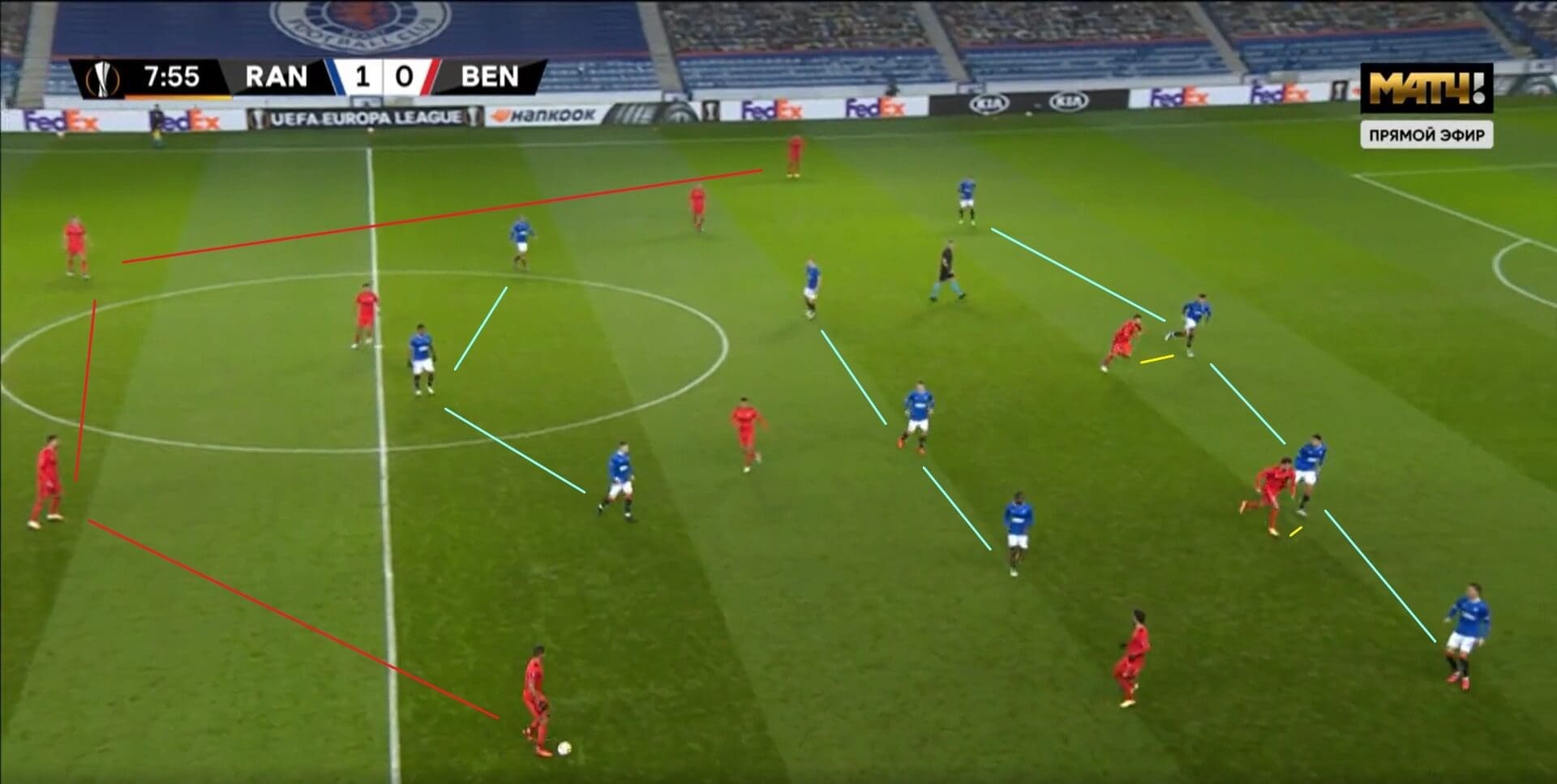
If we look at Rangers’ setup more generally, we can see how their 4-3-3 formation worked. At the front, Morelos, Kent and Roofe were compact in their positioning, with the midfield three of Scott Arfield, Davis and Kamara also working together to stop Benfica finding any spaces behind them. Then the back four are positioned so as to stop the Portuguese side getting behind them, and the yellow lines show how the two central defenders are marking the two Benfica forwards, preventing them getting into the space behind and offering a passing option for their teammates higher up the pitch to aim for.
The whole idea of this is that it forces Benfica to play sideways passes, and we can see how they have stretched out defensively, looking to try and find a way around the side of the Rangers players. However, because of Rangers organised ranks, they couldn’t get the ball into any dangerous areas this way. It is easier to mark players out wide, blocking any crossing attempts they make, and this was exactly what Rangers were looking to do by occupying the central areas and leaving the wings slightly more open.
This meant that, in order for Benfica to create chances, they had to play long balls from the defensive to attacking areas, but this was where Rangers’ defenders were alert, clearing anything that came their way with ease.
Therefore, we can see how Rangers looked to stop Benfica attacking, and how their defensive structure ensured that they went in ahead at half-time.
Rangers’ attack
If we now look at their attack, we can see how Rangers looked to dominate the play in the final third as well.
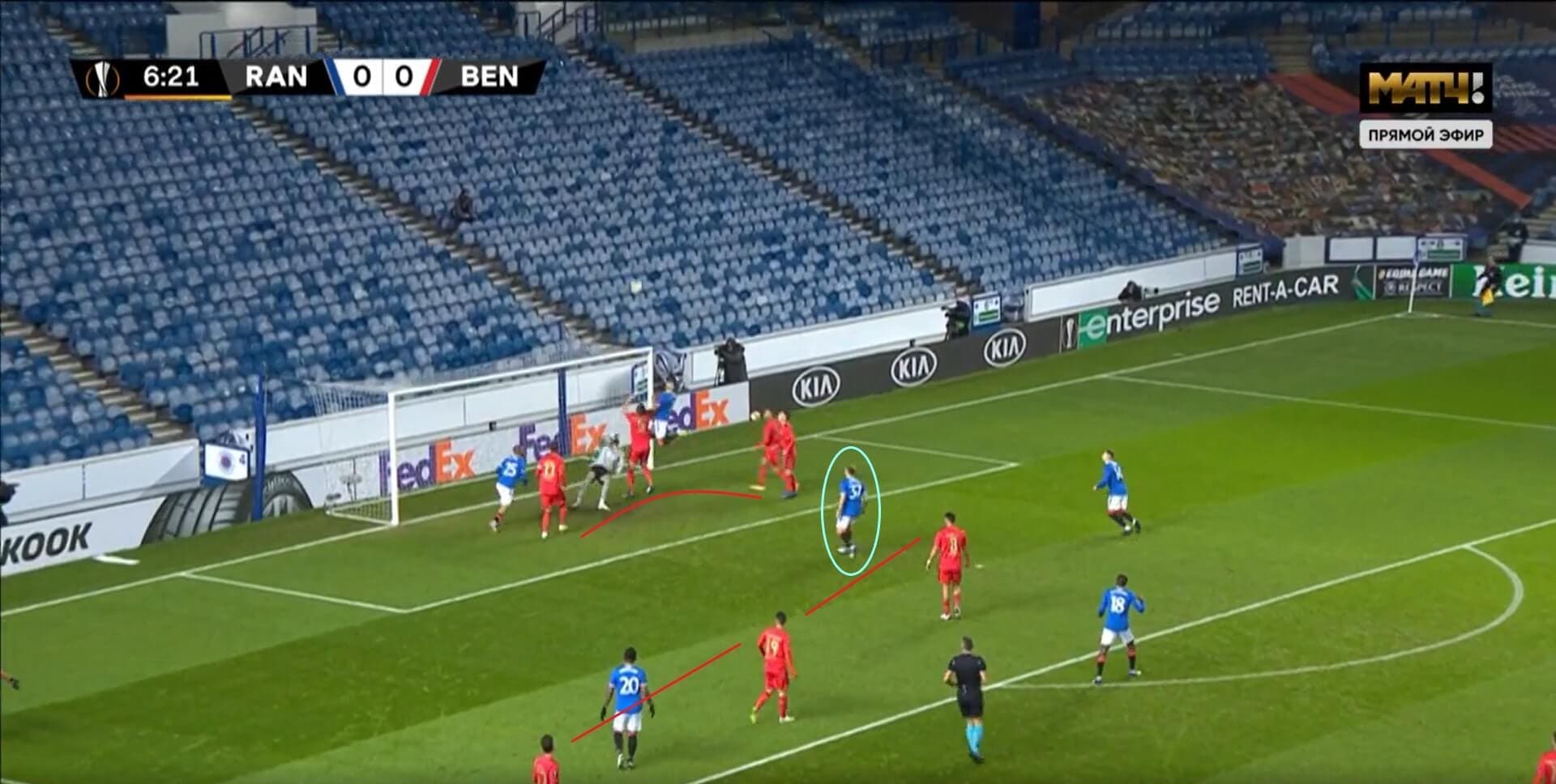
In this image, we can see how Benfica have left gaps in their defence. There is one group of players on the goal line, and another nearer the edge of the box, both marked by the red lines. However, they have left too much space open in between these areas, and that has allowed Rangers, and Arfield here, to get in between them, and he ends up scoring the opening goal here. Therefore, leaving this space open cost Benfica.
We will come back to them, but as far as Rangers went, this example shows how they looked to move their midfielders up the pitch to support the attackers, ensuring that they outnumbered Benfica in this part of the pitch. Benfica couldn’t mark all of the Rangers players, so some, like Arfield here, were left open. Therefore, a combination of Benfica’s indifferent defending and Rangers’ tactics of overloading the attack helped them to control the first half.
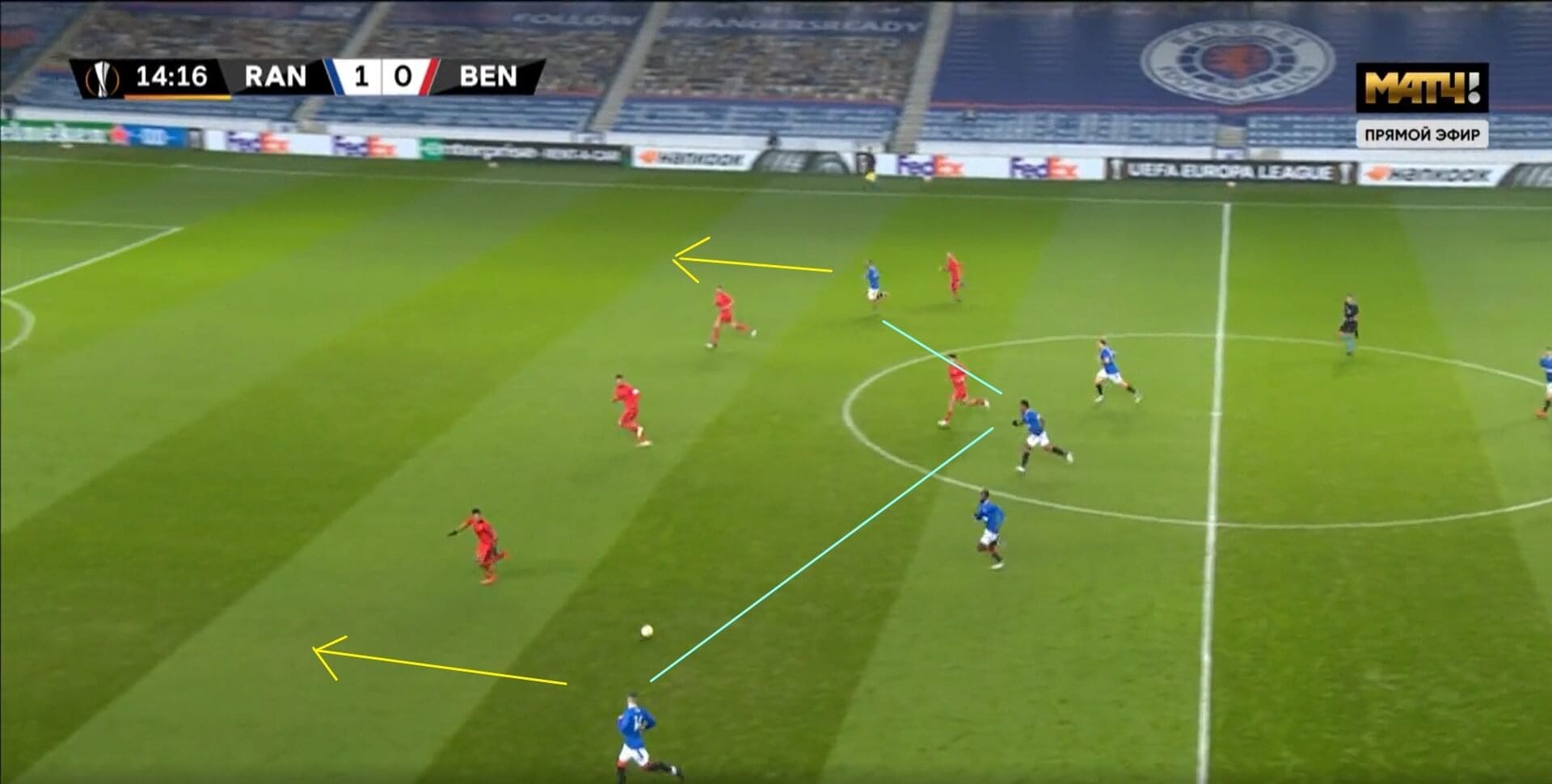
Another key element to their attack was to ensure they controlled the width when going forwards. Here, we can see how Morelos has the ball in the middle, and is passing it out wide to Kent on the near side. The Benfica defence has become too narrow, meaning Rangers can get players either side of it and into the space behind. We know that Morelos is a serial goalscorer, but another of his key qualities is to link up play, just as he is here. This combined quality that he has is the reason he has been linked with a move to bigger leagues, such as Ligue 1.
This time, Rangers didn’t get a goal from their attacking move, but they did score from a similar situation in the second half, as we can see below.
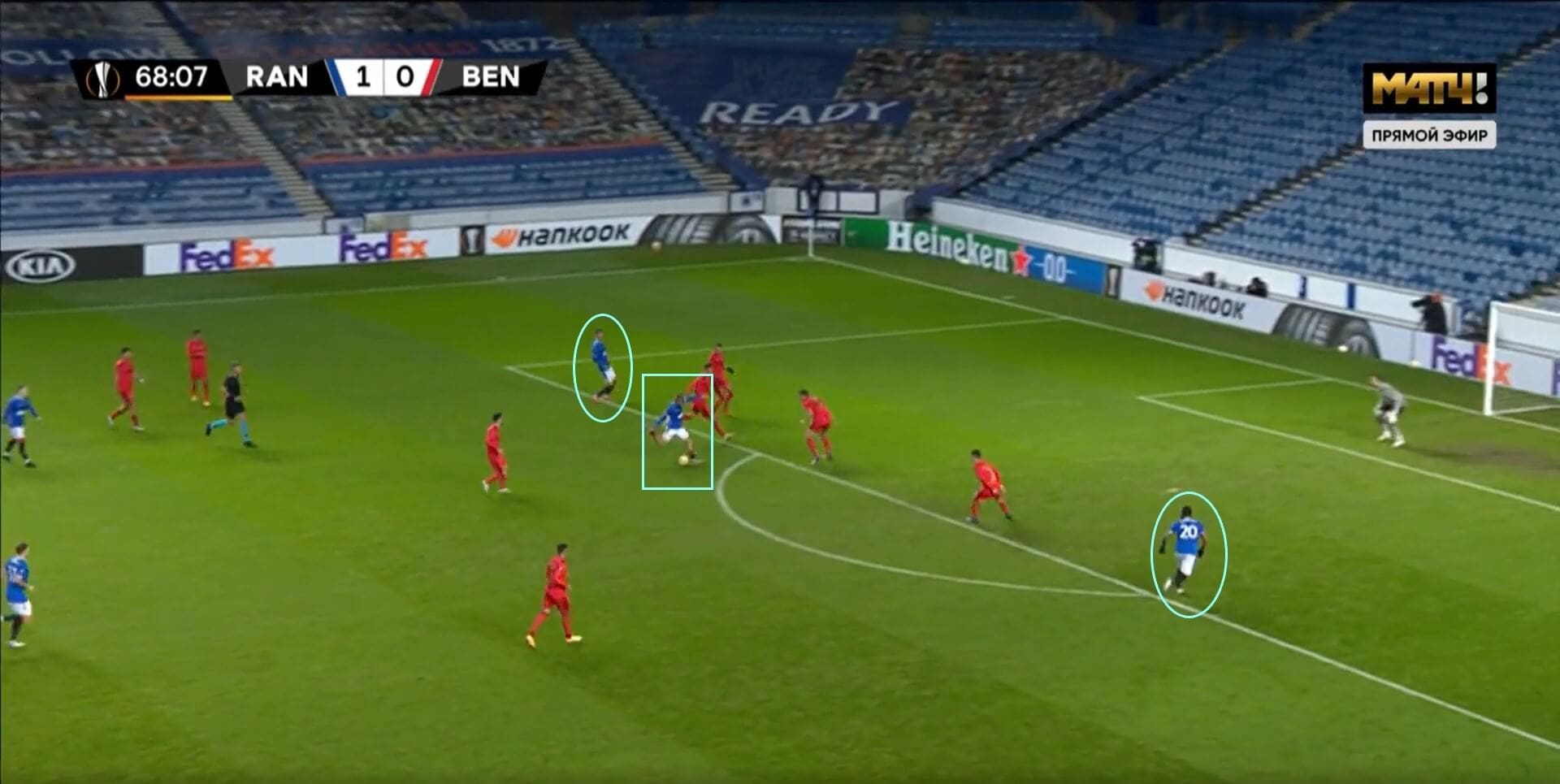
Here, Roofe is the player in the middle, with Morelos and Kent taking up positions either side of the Benfica defence. Again, the defence is narrow, but Morelos and Kent’s role here is to stretch it out, as you can see happening. That then creates gaps in between the defenders, allowing Roofe to have a shot, from which he converts for Rangers’ second goal.
Therefore, we can see how Rangers’ tactic of using the wings allowed them to get into the space behind the Benfica defence, or enabled them to shoot through it, depending on the situation.
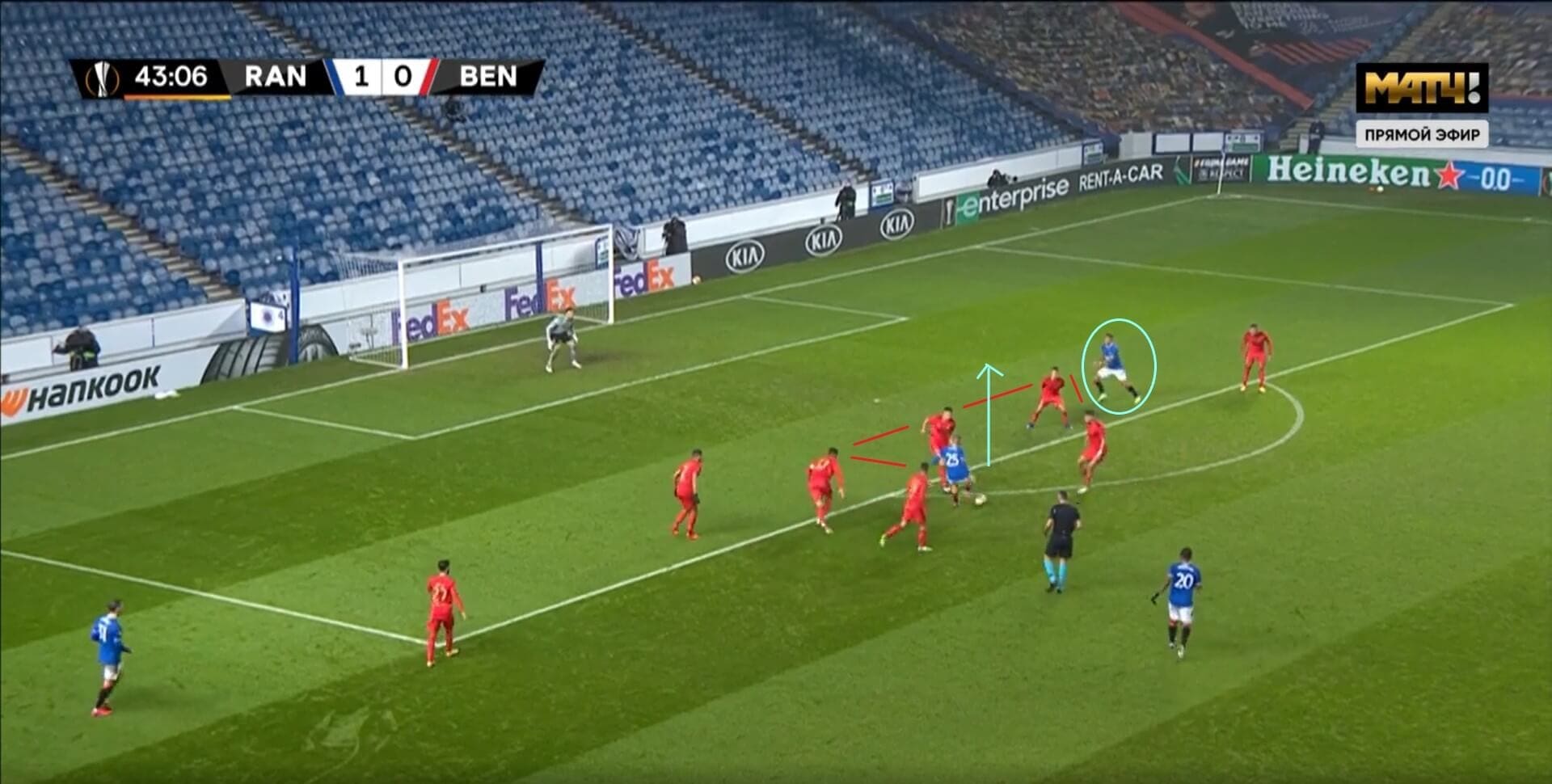
However, whilst they clearly had a plan for how they were going to attack against Benfica, Rangers still didn’t take as many opportunities as they could have done. If we look at this image, we can see how Roofe has the chance to play the ball through to Morelos, as the yellow arrow shows, and the Colombian would then be in a good position to shoot at goal. However, he doesn’t play this pass, instead keeping hold of the ball and eventually losing it under pressure from the defenders around him. Given that the game ended 2-2, a pass through here could have got Rangers another goal, which could have been the difference at the end of the game.
This section has shown us how Rangers looked to attack during the game, aiming to push their wide attackers around the edge of the Benfica defence, and also looking to stretch the opposing defenders apart when they could, creating gaps to shoot through centrally.
Benfica’s second-half tactical changes
Benfica weren’t able to create much in the first half, but they did have a few chances. One of these can be seen below.
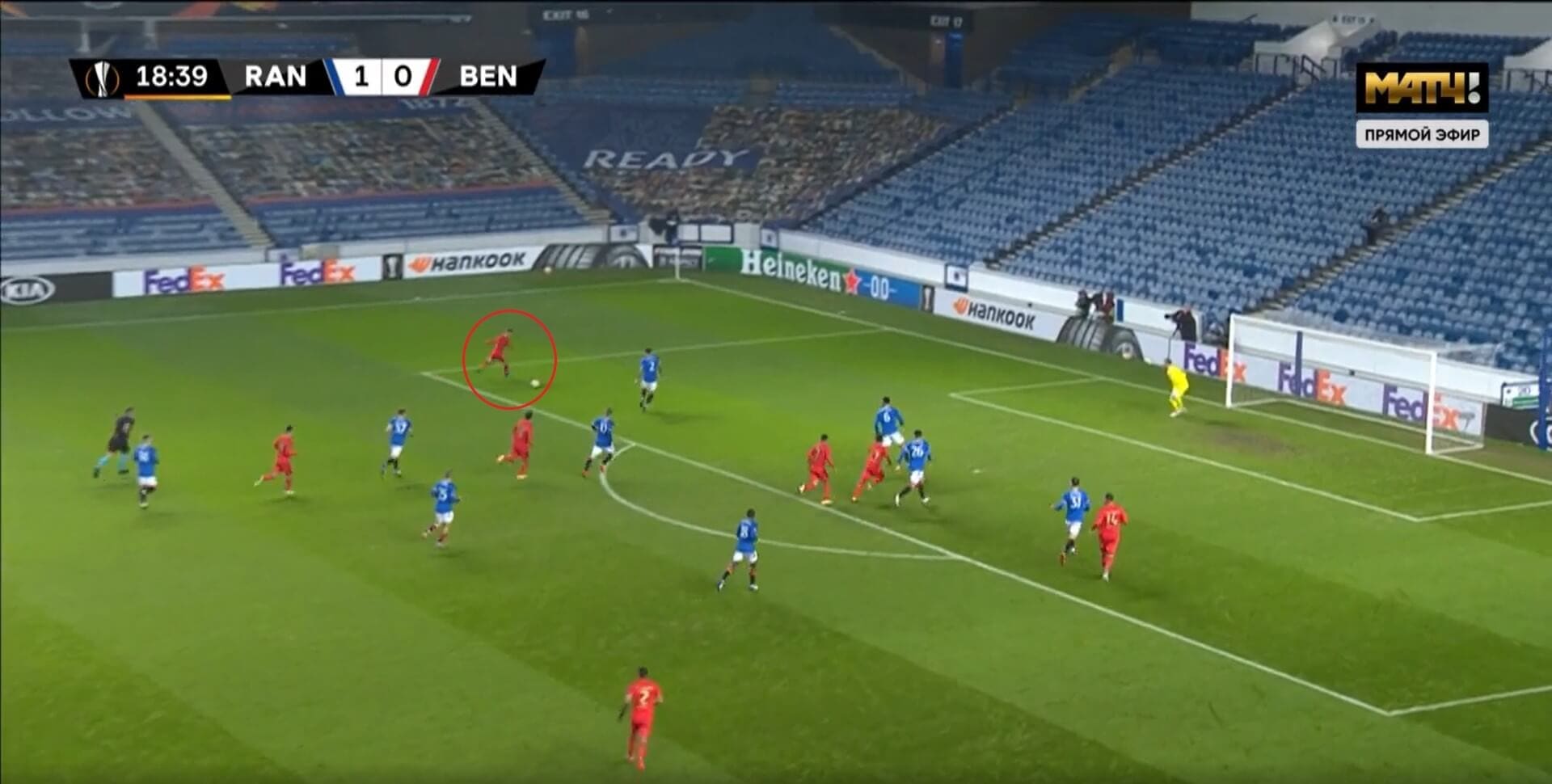
We have already mentioned how Benfica didn’t create many chances in the first half, but this was a good opportunity for them. However, they ended up hitting the ball straight into a defender here. Rangers very rarely let Benfica get into these spaces in the first half, so the visitors needed to take these chances.
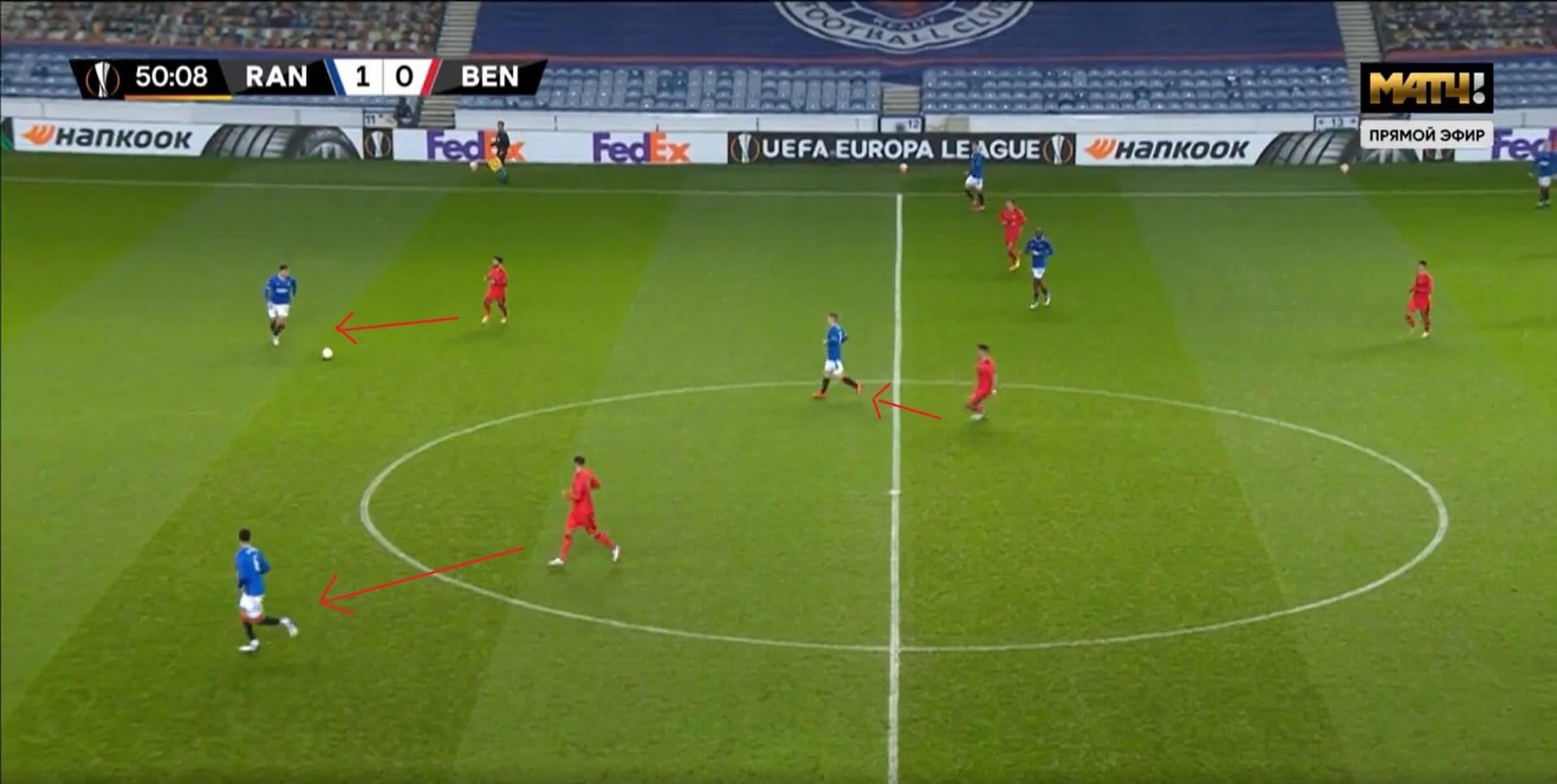
However, in the second half, Benfica came out with some new ideas, one of which was to press Rangers’ defenders when they had the ball. This image shows us how they did this.
Firstly, the two forwards got tight to the Rangers centre-backs, meaning that they couldn’t pass the ball between them in order to get it out of danger, which is what they had been doing in the first half. However, they also couldn’t pass the ball back to the midfielder dropping back to help them out, because he is also being pressed, as you can see. Therefore, Rangers now have fewer options on the ball, and Benfica have taken control from them.
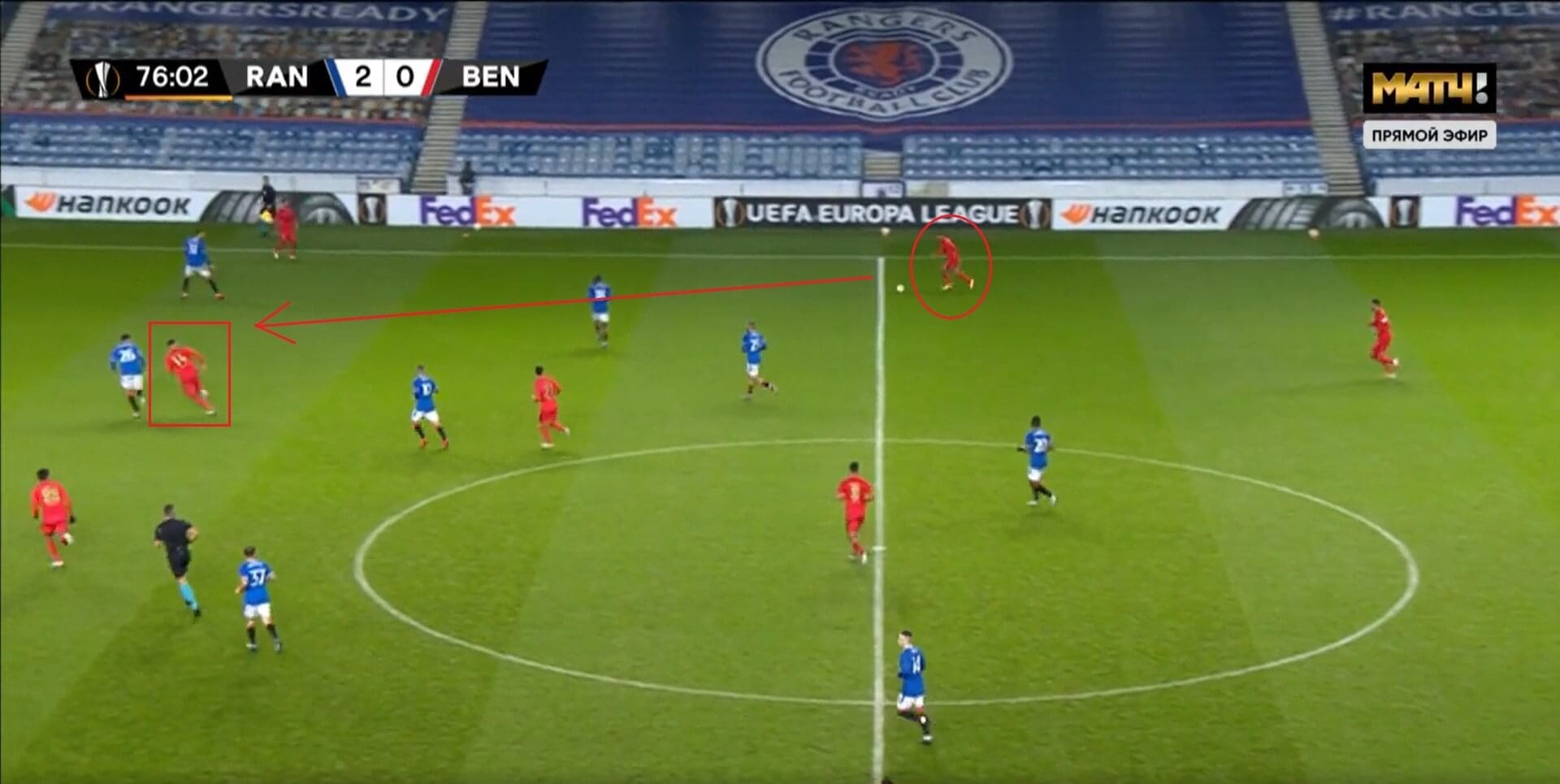
We also mentioned previously how they were forced to play long balls from defence to attack in the first half, but in the second half, they looked to dribble the ball forward much more, trying to keep the ball on the ground rather than in the air, where they had lost a lot of battles. This image shows how they did this, and it asked questions of the Rangers players that they hadn’t had to face before half-time. By playing these passes forwards, Benfica were able to then get their attackers behind Rangers’ defence a little more, especially as the home side in this instance has not narrowed defensively, as they had done in the first half.
Essentially, Rangers dominated the game when the balls were coming into the box aerially, but, when they came along the ground, and from closer distances than the long balls had been coming from, they weren’t able to get back and organise themselves as they had been doing previously.
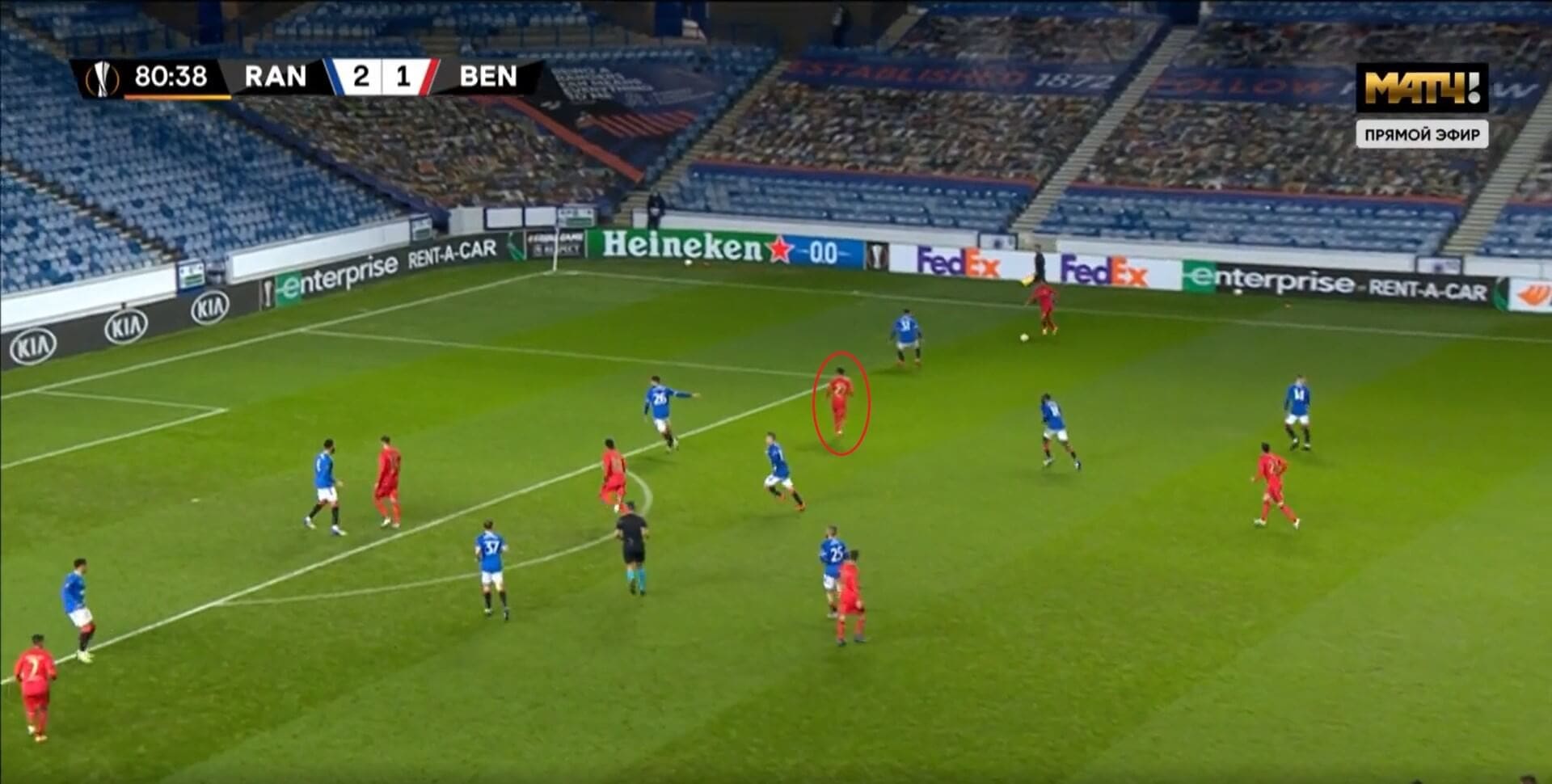
The other thing that Benfica changed was to get their attacking players operating more centrally. Rafa Silva had played in the first half as a wide attacker, but he took up a more central role in the second half, with the full-backs asked to get forward and hold the width instead. That increased Benfica’s threat in the middle, and this image in fact shows us the situation from which Benfica got their equaliser. We can see how getting more players into the attack helped them to take more chances. In the first half, they hadn’t had the right support when attacking, meaning Rangers could close down the shots and frustrate them, but Benfica were able to play more intricately in the second half, and that was what made the difference.
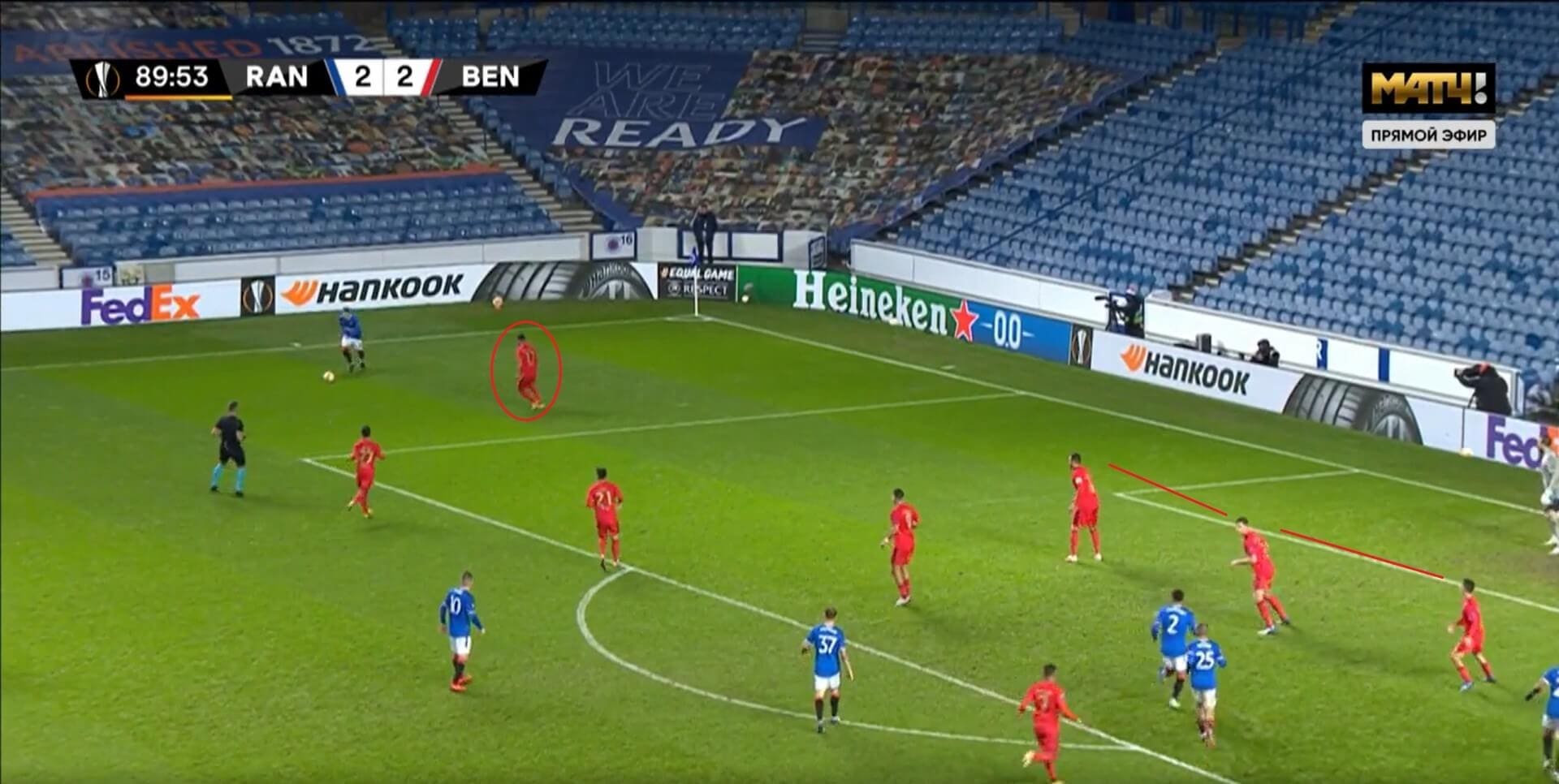
We mentioned earlier how Rangers’ first goal was scored because Benfica had been unorganised in the box, leaving spaces open between their players. However, in the second half, they were more prepared, and we can see here how they looked to stop the ball reaching any Rangers player in the middle from the cross on the far side of the pitch. Three Benfica defenders have formed a line in the box, whilst a fourth defender has moved out to close down the ball, putting pressure on the Rangers attacker to cross it into the box quicker. Eventually, when the ball does come in, it is easily cleared, so we can see how much of a difference this made in the second half, especially in the closing stages of the game when they were looking to protect the point they had earned.
Conclusion
In conclusion, we can see that both sides had positives and negatives to their performances, and both managers will be happy with some aspects of the game and unhappy with others. However, both sides are also now tied on points at the top, five points ahead of the other teams in the league, so that shows how well they have done so far in their other games. Given that, a draw was perhaps not unexpected, with both teams cancelling each other out across the game. Rangers’ next game will see them travel to Falkirk in the Scottish League Cup, before hosting Standard Liege next week, whilst Benfica travel to Maritimo before hosting Lech Poznan in the other Group D game on Thursday.





Comments